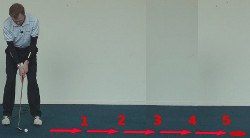
Golf improvement is a never-ending process. Just look at the pros, who hit hundreds of practice balls and spend hours chipping and putting on a daily basis.
Few amateurs can invest that kind of time on golf. But you can achieve continual improvement by focusing on a few key items. Follow this checklist and, provided you work at it, you'll enjoy regular progress toward lower scores.
- Make sure your equipment fits: If your clubs aren't built to match your body and swing, you'll never maximize your potential. In fact, you're likely to develop bad habits as you unconsciously adjust your swing to fit your clubs. Clubfitting integrates measurements like height, hand size and wrist-to-floor distance into your clubs' specs (length, lie, grip size), greatly bolstering your chances of success. Clubfitting can be done online, free, through the Thomas Golf website.
- Another way on How to Improve Your Golf Game is practice the short game: It's a widely-cited statistic that putting accounts for about 40% of a typical golfer's strokes – far more than any other aspect of the game. Make a point to practice your putting, especially inside five feet. It's also relatively easy to get better at chip shots, pitching and bunker play. Solid short game skills are less likely than the full swing to desert you without notice, so any time spent honing them is time well spent.
- Limit your practice with the driver: No doubt about it, the driver is the most fun club to hit. That's why many of us blast one range ball after another after another with the big stick. Trouble is, we don't use it enough on the course – about 14 times per round at most – to justify so much practice. Yes, it's helpful to be long and accurate off the tee. It's more important to be a consistent iron and hybrid player. Plan your practice sessions accordingly.
- Take lessons from a pro: For beginners, it's critical to learn the fundamentals, and only a certified teaching pro can educate you properly. For more experienced players, occasional lessons or even a series of sessions can help you fix swing faults or fine-tune different aspects of your game. Here's a definite sign that you should seek professional help: You often find yourself muttering, “What am I doing wrong?” A good teacher can tell you.


If you really want to go far in this game, focus on building a low-maintenance swing building a low-maintenance swing. As the term implies (How to Improve Your Golf Game), it's easier to achieve consistency and correct yourself when things go wrong if your swing is relatively simple.
Every golfer wants to get better.

That is a statement that holds true across the game – from the total beginner all the way up to the top professionals. One of the great things about this game is the fact that everyone can improve. There is no such thing as a perfect golfer, as every player has something that he or she can work on moving forward. It's hard to become bored or satisfied in this game since there is always another level of play to be attained.
Of course, while it is fun to chase improvement in this game, it can be overwhelming at the same time. With so many different areas of the game to consider, how do you know where to focus your time and energy? What should you work on in order to actually make progress? These are tough questions, and many amateur golfers get stuck at this point. Without a plan to work from, many players just hit shots on the driving range without any sense of purpose. Those players usually don't get much better, and they will remain at their current level of play for years to come.
If you are going to improve at golf, you need to have a plan. That plan needs to be customized to your needs, since your game is unique to you. The strengths and weaknesses you have in your game are going to determine the best path forward, so you need to be willing to look at them honestly. What do you do well currently in your game, and where do you struggle? Attacking your weaknesses and maintaining your strengths is the right way to move forward.
In this article, we are going to provide a variety of tips on how you can improve at golf in the weeks, months, and years ahead. Of course, we've never seen you play, so we can't outline exactly what you should do. However, we can provide general tips which can then be molded to fit your needs. Remember, improvement in this game is ultimately up to you. It's worthwhile to get advice from an instructional article or a local golf pro, but the job eventually lands on your shoulders. If you are going to get better, you are going to need to put in the effort, and you are going to need to make smart decisions. We hope the advice provided below helps to move you in the correct direction for a bright golfing future.
All of the content below is based on a right-handed golfer. If you happen to play left-handed, please take a moment to reverse the directions as necessary.
Establishing Core Skills

There are certain core skills that you must have in order to play this game successfully. Whether you are hoping to break 90 for the first time, or you have shot in the 80s many times and want to crack into the 70s, the skills below are indispensable. Before we can really talk about ways to improve the other aspects of the game, we need to make sure you have a solid foundation in place. Only when you are relatively happy with the way your game is working in the categories listed below should you move on to addressing other issues.
- Solid play off the tee. This is where everything starts. It is nearly impossible to play good golf if you can't get off the tee reliably hole after hole. Do you need to be the longest hitter at your club in order to play well? Of course not. Do you need to hit every single fairway? Nope – no one does that. However, you do need to have a nice blend of power and control if you hope to keep your game moving forward. Between those two aspects, control is by far the more important element. If you can keep the ball on the short grass most of the time, this game will feel far easier than if you are trying to play from the rough. There is nothing wrong with working to add yards to your average drive, but never do so at the expense of your accuracy. Only make changes that permit you to hit the ball harder if you are sure you'll be able to maintain or improve your percentage of fairways hit after the change is made.
- Make your short putts. Another building block of good golf is the ability to make short putts on a consistent basis. If you have been playing this game for any length of time, you already know how frustrating it can be to miss a significant number of short putts. Missing from inside of three feet feels like a wasted shot, and there is nothing you can do to get that shot back. Of course, no one makes every single short putt they ever face, so give yourself a pass if you happen to miss from time to time. However, if you start to notice that missed short putts are a pattern in your game, you'll want to take action before the problem becomes too severe. Work on the basics of your putting technique and hit plenty of short putts in practice to make sure your confidence is as high as possible before stepping onto the course.
- Clean strikes with your irons. There is a lot that goes into hitting good iron shots. Your swing technique needs to be solid, you need to pick the right iron for the shot at hand, and you need to read your lie correctly. Most of the time, you are hitting your irons directly off the ground, which is far more difficult than hitting the ball from a tee. In the end, your success or failure with iron shots is going to mostly come down to how cleanly you contact the ball at the bottom of the swing. If you are able to achieve a clean strike, all should be well. If you struggle to do so, however, it's always going to be tough to hit greens in regulation. Make the improvement of your ball striking a top priority until you feel confident that most of your shots will be struck well enough to travel roughly the distance expected.
- Stability under pressure. There is a belief among some golfers that pressure is only an issue for the top players. When millions of dollars are on the line, pressure obviously comes into play. With that said, it is important to recognize that pressure is present for amateur golfers just the same. In fact, you can feel pressure when out playing a solo round before work on a weekday morning. If you care at all about your performance, you will get nervous from time to time. So, in turn, the ability to maintain your level of play when you feel pressure is a core skill in golf. Rather than trying to pretend that the pressure doesn't exist, you should accept it, acknowledge its presence, and play well anyway.
If you can feel good about the four points above, you'll be well on your way toward a solid golf game. Of course, building up your game to where you are happy with your performance in all of those categories is easier said than done. Many players take part in this game for decades without ever reaching a satisfactory level in all four areas. Center most of your practice efforts on these points until you feel like a great foundation is in place.
Eliminating Holes

Now that you understand what a solid base for your golf game should look like, we can move on to talking about eliminating holes. No, we aren't going to be skipping holes on the course as a way to lower your scores. Rather, we are talking about getting rid of some of the holes in your game that may be causing you to waste strokes. These are the parts of the game that you dread having to put into action, because they always seem to let you down. Without any further explanation, you can probably think of one or two areas of your game that give you trouble more times than not.
The first step toward closing up some of the holes in your game is to accurately identify those holes. You may have one or two that come to mind, but are those the only areas that are letting you down? And are those areas actually problems, or is your perception altered by a couple of memorable bad shots recently? The best way to identify the problems in your golf game is to do an accounting of where you are losing strokes. For the next few rounds you play, take some notes on your scorecard along with the score you write down for each hole. Those notes should include information on what, if anything, caused you to lose strokes on a given hole. So, if you make a par or birdie, you probably won't need to write anything down. However, if you make a bogey or worse, there is going to be something to note with regard to why you lost a shot (or two, or more).
After you've done this kind of tracking for a few rounds, take a look back over your scorecards to identify any patterns you can find. Are you wasting strokes in or particular area specifically? Most likely, the answer is yes. With the homework done and the problems in your game accurately identified, you can move forward to making improvements.
At this point, the job gets very easy – yet many amateur golfers still manage to go wrong. What should you do once you know what parts of the game give you trouble? You should practice those parts of the game! Revolutionary, we know. Unfortunately, this is not how most golfers operate. When the average golfer heads to the driving range, he or she tends to work on the parts of the game that are already a strength. For instance, if you already hit your driver well, you may be tempted to stand up on the range and hit driver and driver into the distance. It feels good to hit good shots, even if they are only in practice. You might have an enjoyable practice session that way, but you won't have made much progress toward improving your game. It's fine to spend a bit of time on the parts of the game you already have under control, but most of your effort should be invested in areas that give you trouble. If you make it a habit to practice your weaknesses, those areas should improve, and your entire level of play will take a step forward.






